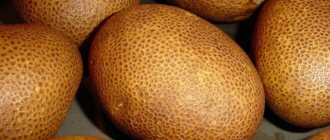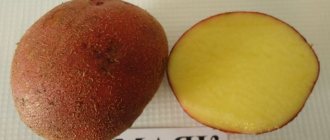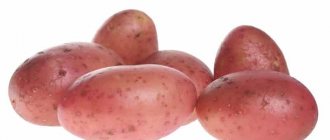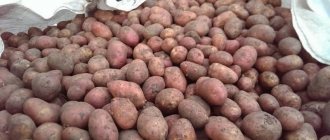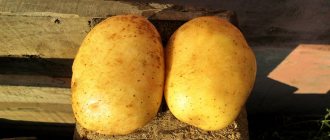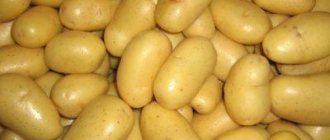The Zhukovsky potato variety is easy to care for, growing it does not cause any trouble, it is a pleasure. With the right approach and regular implementation of all necessary procedures, the yield of the variety increases significantly. Already in the first summer months, gardeners eat delicious new potatoes. The article reveals recommendations for growing and caring for crops.
History of selection and distribution
At the end of the 20th century, by crossing two varieties, breeders managed to develop a disease- and drought-resistant variety - early Zhukovsky. It was intended to be grown in regions with a temperate climate, but excellent results were shown in all climatic conditions.
The variety is adapted to various soil types. It is recommended to grow in the Far Eastern, Northwestern, Western Siberian, Central, Ural, Volga-Vyatka, Lower Volga, Central Black Earth, Middle Volga, North Caucasus regions. The variety was included in the State Register of the Russian Federation in 1993.
Description and characteristics
Potatoes "Zhukovsky" are considered one of the most popular among vegetable growers. It has average yields, but is preferred due to the fact that it has many advantages.
The variety is characterized by the following criteria:
- Bush. Semi-spreading bush with numerous strongly branched shoots. Large, dark green foliage with grooved veins. Blooms evenly and abundantly, not for long. The inflorescences are small and do not form fruits. The flowers are pinkish-violet with a white tint at the tips of the petals.
- Tubers. Root vegetables are distinguished by a neat, round shape of medium or small size. The peel is thin, pink in color, and the surface is smooth. There are a small number of eyes. Up to 12 potatoes are harvested from one bush. The pulp is dense, white, watery. The mass of tubers varies from 100 to 120 grams. Keeping quality is 90-92%. Root crops do not lose their attractiveness when transported over long distances.
- Nutritional value. A special feature of the variety is the content of many vitamins, organic acids, protein, and bioflavonoids. Potatoes are also rich in minerals: phosphorus, sodium, potassium, calcium, magnesium. There is little starch in potatoes - up to 12%. Low-calorie variety.
- High resistance to diseases. Zhukovsky potatoes practically do not suffer from potato diseases. Has good health, does not succumb to common scab, golden nematode, and potato cancer. It is moderately resistant to late blight.
- Taste qualities. It is used for boiling, frying, jacket cooking, and deep-frying. Does not lose shape during heat treatment. Root vegetables are tasty and slightly sweet.
| Characteristics of potatoes | |
| Variety name | Zhukovsky early |
| general characteristics | table variety, guaranteeing excellent taste, preservation of presentation during transportation, unpretentiousness |
| Maturation period | 60-70 days |
| Weight of marketable tubers | 100-120 g |
| Starch content | 10-12% |
| Peel color | pink |
| Flesh color | white |
| Number of tubers in a bush | 10-12 |
| Productivity | 400-450 c/ha |
| Keeping quality | 90-92% |
| Disease resistance | resistant to all diseases |
| Consumer qualities | More often, young potatoes are boiled, baked, and made into chips |
| Features of cultivation | does not require special care, germinates even in poorly heated soil, does not form berries |
Description of the variety Zhukovsky
The Zhukovsky variety has been known to gardeners since the early 90s, when it was included in the register. The bred type of potato absorbed the best qualities of the species. It turned out to be adapted to different soils and climatic conditions. Suitable for cultivation in the central regions, North-West, North Caucasus, Volga regions, the Urals and Siberia, the Far East. The variety belongs to the universal or salad variety.
Late or early
Zhukovsky potatoes are early ripening varieties. Ripens in the summer-autumn period and is not stored for long. You can dig up new potatoes after 40 days. A fully ripened vegetable is obtained in 50-60 days.
The bushes grow medium in size, stem, slightly spreading. It blooms for a long time, the flowers are light lilac.
Characteristics of tubers
Root vegetables have a beautiful presentation, pinkish, translucent, smooth skin, white pulp. The texture is dense and pleasant. Size is medium or large, 100-150 g. Shape – oval. The eyes are small, pink, sharp, but noticeable.
After heat treatment, the pulp becomes soft, sweetish, and does not darken after cooking and peeling. The texture does not fall apart, dense, slightly watery. The tubers do not get soft after cooking and keep their shape.
Taste qualities
Potatoes are valued as universal. It is suitable for mashing, baking and frying, baking, soups, making crispy potatoes. After cooking, the potatoes retain their presentation. The potatoes taste sweetish, slightly watery, not dry or mealy.
Productivity
From each bush you can collect up to 10-15 tubers. Depending on the care and planting material, the variety can be productive or moderately productive. You can harvest up to 500 kg per hectare.
Ripening time
Zhukovsky is an early ripening variety. The first tubers can be dug up already in mid-July, of course, if the potatoes are planted in early May. Fully mature root crops are dug up in late August-early September.
Disease resistance
The variety was bred to be resistant to various diseases. Zhukovsky has high resistance to cancer, nematode, scab, mosaic virus, bacteriosis and rhizoctonia. But susceptible to late blight. To prevent the spread of the disease, it is recommended to cut down the tops at the end of July.
The value and disadvantages of Zhukovsky potatoes
Gardeners value the variety for many positive aspects. It also has disadvantages, but they are quite minor, but it is important to know about them before you start planting:
| pros | Minuses |
| The disadvantage of the Zhukovsky variety is the deterioration of taste if the harvest is untimely, and also the fact that frequent rains can cause late blight in potatoes. |
Secrets of cultivation
Early Zhukovsky potatoes, which are characterized by increased resistance to low temperatures, compared to other varietal varieties, can germinate quite early. Amateur gardeners plant prepared seed fruits in mid-April.
Important. It is better not to cut root crops prepared for seed, since during germination such specimens may rot or produce a small number of stems, which will significantly affect the reduction in yield.
In order for seed tubers to germinate quickly, they should be placed in prepared boxes ahead of time and left in favorable room conditions for 2 weeks. At this time, the seed potatoes should be covered with something that helps disperse the sun's rays. For rapid germination, periodically moisten and turn the potatoes.
Simultaneously with the above manipulations, they should be disinfected. A potassium permanganate solution is perfect for this procedure. Disinfection of fruits is carried out once every 7 days. In parallel with this, treatment is carried out against various diseases and potato pests. For this purpose, you can use special chemicals. drugs. They are able to repel parasitic insects and reduce the risk of a wide variety of diseases that lead to the death of the plant.
After the formation of sprouts having a length of 1 cm, the root crops should be planted on the prepared area, after digging it up and applying various fertilizers.
Advice. If potatoes have many sprouts, then such bushes will contain more fruits in the future.
The Zhukovsky potato variety, whose characteristics indicate the possibility of early planting, is still afraid of frost. It is usually planted in mid-April. Recently, in all regions of the Russian Federation, excluding the territory in the south, frosts are often observed in April - almost May. To reduce the risk of freezing, cover the area with a special material containing agronomic fiber.
Preparing for landing
Growing Zhukovsky potatoes is no different from growing other early varieties, but has some points that should be taken into account. The following points come into play here.
Soil preparation
Despite the fact that the variety is unpretentious to the soil, to obtain high yields it is not recommended to grow the crop in damp clay areas, as well as in places where the soil is depleted and acidic. In dense, organic-poor soil, the tubers will grow small and tasteless. In addition, they will often suffer from diseases. It is better to give preference to sandy soils and light loams fertilized with organic matter.
The soil for potatoes is prepared in advance in the fall. Dig up the soil to a depth of 25 cm, add ash and rotted compost (35-40 buckets per 100 square meters). In spring, additional nitrogen fertilizers are required. Then the soil is loosened and leveled. It is advisable to plant Zhukovsky potatoes on land where cucumbers, cabbage, legumes, and green manure previously grew.
Germination of tubers
For germination, potatoes are taken out of storage 15-20 days before planting. Early varieties are planted around the third decade of April, and seed germination begins at the end of March.
Germination procedure:
- Carefully inspect the tubers for planting, reject potatoes with damaged skin, wet or dry rot, or non-standard shape. If the potatoes have already sprouted in the basement and their sprouts exceed 5 cm, they are removed.
- To prevent potatoes from taking up a lot of space, experienced gardeners recommend using low boxes about 10 cm for germination, filling them with planting material, and stacking them on top of each other. If there is enough space in the room, the tubers are scattered on the floor in one layer.
- The room should be light and the air temperature should not exceed +5-10 degrees. Zhukovsky potatoes need this temperature. The room must be periodically ventilated and the air humidified. If the sprouts are strong and have grown to 1 cm, and the skin has turned green, the tubers are ready for planting. Potatoes with thin sprouts are not suitable for planting.
It is possible to reduce the germination time as follows: sprinkle the potatoes in the boxes with wet sawdust or humus, and sometimes sprinkle with warm water. Leave the potatoes in the light, but not in the sun. This method allows you to get strong sprouts with roots within 15 days. They are planted by hand - this prevents damage to the roots.
Landing
Before planting, the tubers are treated with wood ash at the rate of 400 g of ash per 50 kilos of potatoes. The use of special preparations is allowed, such as Bordeaux mixture, Maxim, Prestige. The procedure helps accelerate the development of the root system and protect potatoes from pests and diseases during the formation period.
The Zhukovsky potato variety is planted in rows, leaving a distance of 25-30 cm between tubers and 60-70 cm between rows. With this planting, 5-6 bushes can easily be placed. The depth of planting potatoes in the soil is no more than 6 cm. It is advisable to plant when the soil warms up to a temperature of +5-6 degrees.
Agrotechnics of cultivation
In about a month, the seed material is taken out of the cellar for germination. The tubers are sorted, removing those that are too small, flaccid, or with signs of damage or disease. Seed material is not cut into pieces before planting, because this significantly reduces or completely loses the characteristics of the variety.
For germination, potatoes are placed in boxes, bags or simply on newspaper in a room where the temperature should be maintained in the range of +5+19 degrees Celsius.
Lighting should be diffused.
In room conditions, the seed material should be turned over and moistened. It is recommended to add potassium permanganate to water intended for moistening to disinfect tubers. The disinfection procedure should be carried out every 6-8 days.
Also, Zhukovsky potato planting material must be treated against diseases and pests. For this purpose, special disinfectants are used to repel pathogenic microorganisms and “harmful” bugs.
On a note!
Tubers of the Zhukovsky variety should be planted when sprouts up to 1 cm long appear on them.
6-8 days before planting Zhukovsky potatoes, it is necessary to dig up the area intended for this vegetable crop or dig it up with a tractor. The planting site should be chosen on the sunny side of the garden.
Secrets of growing large potatoes from planting to harvesting - video
The composition of the soil is not of fundamental importance, since Zhukovsky potatoes grow on all types of soil. However, you need to follow the rules of crop rotation and not plant this crop in one place more than once every 2-3 seasons.
Growing methods
Depending on the soil types and natural conditions, the optimal method for growing potatoes is selected. The most common methods of planting Zhukovsky potatoes are:
| Flat fit | Ridge planting | Trench planting |
| The tubers are placed in holes, covered with earth, and leveled with a rake. Lay the potatoes 8 cm deep. | This method is suitable for regions of Siberia where there are cold snaps and flooding. The tubers are placed 5 cm deep in the ground and, after germination, they are hilled up so that the sprout is completely covered with soil. When the sprout appears above the ground again, they spud again. This procedure is carried out until the height of the sprout reaches 15 cm. | The cultivation method is intended for arid regions. Dig a trench to a depth of 10 cm and fertilize. The tubers are placed sprouts up and covered with soil. The surface of the earth is mulched - this helps retain moisture in the soil. |
Rules for growing potatoes
Zhukovsky potatoes do not require special planting technologies; the principle is standard. With proper planting, the chances of getting a bountiful harvest will be high.
Soil preparation
In order for potatoes to bear fruit abundantly, it is necessary to prepare the soil. Do not plant it in heavy, clay soil. If it is highly oxidized, yields will suffer. When the soil is poor, depleted, with a low amount of organic components, the fruits will be small and tasteless. It is advisable to plant the vegetable in sandy soil or loam. Before planting, you should fertilize it with nutrients.
See also
Reasons why potato tops turn yellow and dry and what to do about it, methods of treatment and protection
Read
Preparation of planting material
Potato yield depends on the quality of planting material. You should choose healthy, oblong tubers weighing 150 g. The sprouted vegetable appears 10 days earlier. Material for planting should be prepared 1 month in advance. Preparation includes the following steps.
- Treatment of tubers against diseases and harmful beetles using Maxim.
- Transfer the planting material to a place with a temperature of 10 to 13 degrees Celsius.
- Root vegetables are laid out on a rack or boxes in one layer.
- When the sprouts reach 1 cm, they are ready for planting.
- To reduce germination time, place the fruits in a peat mixture and periodically spray the tubers with water.
To increase germination and ensure high protective properties, potatoes are kept in bright light for 10 days until the skin turns green. The sprouted root crop is planted by hand so as not to damage the sprouts.
Time and landing pattern
Potatoes should be planted in open ground in late April or early May, depending on the climatic characteristics of the region. The soil should be moist so that the spade bayonet easily sticks together into a lump and does not crumble. Maintain a distance between tubers of 30 cm, between rows - 60 cm. The optimal depth is 10 cm. If there is a lot of clay in the ground, it is better to reduce it to 7 cm. Potatoes are planted in even rows, or under a cord. Then it will be easier to care for him in the future.
Features of care
For Zhukovsky potatoes, the basis is timely planting of tubers and harvesting. 5-7 days after planting, the soil is loosened, removing weeds and also supplying the soil with oxygen. Loosening is carried out to prevent attacks by pests such as mole crickets and the Colorado potato beetle.
Early varieties are resistant to drought; they only need moisture from the spring soil. There is no need to water the plants additionally, only in exceptional cases, for example, if there is intense heat for a long time. The procedure is carried out early in the morning.
Potato bushes do not need additional feeding. When preparing the site, organic fertilizers are applied in the form of any manure.
Further care for the Zhukovsky potato variety
This potato variety is considered drought-resistant, but it still needs to be watered. The beds should not be over-watered; watering should be carried out when the top layer of soil has dried; half a bucket of water should be added to each square of the plot.
After each watering, it is necessary to loosen the soil to remove the dry crust that forms on the surface of the soil. This procedure allows moisture and oxygen to better penetrate to the roots of the plant.
At the same time as loosening, weeds are removed, which clog the potato bushes and take away nutrients from them for their growth.
Also, during the growth of potato bushes, Zhukovsky will have to fight the Colorado potato beetle, against which this variety has no resistance.
At the end of July, it is recommended to cut off the potato tops, since the tubers have already formed by this time, and this procedure will protect the plants from being affected by late blight.
What will help increase potato yield?
Hilling
This potato variety requires hilling several times during the summer. The first hilling of the Zhukovsky variety is carried out during the budding period, then as needed.
We recommend:
Zhuravinka Potatoes Milena Potatoes
Hilling helps protect growing tubers from excess moisture, additionally saturates the roots with oxygen, protects the bushes from falling apart, and also promotes the formation of additional tubers.
How to deal with pests and diseases?
The value of the Zhukovsky variety is that it has increased resistance to the following diseases: potato canker, rhizoctosis, alternaria blight, golden nematode. But potatoes are most susceptible to late blight. Despite the strong immunity, the gardener should know that if the plant gets sick, it may have defining symptoms. Potatoes can also be attacked by Colorado potato beetles.
The table shows symptoms and methods of controlling pests and diseases.
| Disease/pest | Symptoms | Ways to fight |
| Potato cancer | Accompanied by the formation of dark growths, similar in appearance to cauliflower. | To avoid the development of the disease on other plants, getting rid of affected bushes and cultivating the soil will help. For preventive purposes, the drug "Benomil" is used. |
| Golden nematode | A parasitic worm that reproduces on the roots of a plant and, as a result of its vital activity, forms bald spots on it. | The fight is carried out through the use of chemicals. The most popular chemical is Bazudun. For prevention: before planting, potatoes are treated with a solution of potassium permanganate, observing crop rotation. |
| Alternaria blight | Brown and dark brown spots appear on the leaves, which is why they subsequently dry out and fall off. | The disease is incurable, but requires prevention. They cultivate the land before planting, observing crop rotation. In this case, a solution of potassium permanganate or preparations containing copper helps. |
| Late blight | Select healthy root crops from infected potatoes immediately before planting. This will significantly reduce the risk of late blight. This problem can also be solved by early ripening of the crop, if the tops are removed 7-10 days before harvesting. | |
| Colorado beetle | Destroys the leaves of the plant. A very voracious pest. It has high survival rate in different conditions and quickly gets used to toxic chemicals. | It is difficult to get rid of it due to its high fertility. It is recommended to avoid such addiction by using different active ingredients. The fight against the beetle begins in early spring and ends in late autumn. Fighting methods:
|
Diseases and pests
The Zhukovsky variety resists diseases such as potato canker, black scab and Alternaria blight. However, due to improper care, late blight may occur. To cope with a dangerous disease, experts recommend treating the plantings:
- Fitosporin-M;
- Bordeaux mixture;
- copper sulfate.
Invasion of pests such as the Colorado potato beetle and mole cricket causes great damage to potato beds. Pests are removed from the bushes manually or the plantings are treated with insecticidal agents. To save Zhukovsky seed potatoes from the mole cricket, you should plant calendula bushes near the beds.
Zhukovsky potatoes are one of the most popular early varieties. The vegetable crop is widely used not only when grown in private areas, but also on an industrial scale, since the tubers tolerate mechanical harvesting well. A high level of resistance to fungal diseases is a significant advantage.
Harvesting and storage
Potatoes "Zhukovsky" ripen 60 days after planting. The variety is highly resistant to mechanical damage, making it possible to harvest using automatic devices.
Potatoes are stored in a dark room at a temperature of +2-5 degrees. When the temperature rises, the potatoes will begin to sprout; when the temperature drops, they freeze, spoil, and their taste deteriorates. It is better to place root vegetables in wooden boxes or bags. Read more about proper storage of potatoes here.
Major diseases
Zhukovsky potatoes are highly resistant to the following diseases characteristic of other potato varieties:
- potato cancer;
- scab;
- rhizoctonia;
- nematode.
The resistance of this variety to late blight, alternaria and most viral diseases is average.
, but sufficient so that plant yields do not suffer significantly.
Reviews from gardeners and farmers
It is impossible to hear anything bad about Zhukovsky potatoes. Gardeners and farmers speak positively about the variety.
★★★★★
Tamara, 44 years old, housewife. Our family loves young, sweet and tender potatoes.
For ourselves personally, we plant the “Zhukovsky” variety every year. It pleases with good yield, beautiful-looking tubers - pinkish skin, round shape, large mass. When cooked, potatoes do not become soft and do not lose color. We don’t leave potatoes for storage; they have time to last until the end of the year at most. ★★★★★
Artem, 36 years old, gardener. My parents trust exclusively the early-ripening potato variety – Zhukovsky.
I didn't like this variety. It has good taste, but at a young age, the tubers are still small. Then the potatoes become larger and their quality is lost. The roots spread to the sides, and you have to look for potatoes throughout the garden. I also didn’t like the fact that it is constantly attacked by the Colorado potato beetle, the plant is affected by late blight. It is necessary to carry out treatment regularly. ★★★★★
Gennady, 50 years old, farmer. Zhukovsky potatoes are actually a very early variety.
Already at the end of the first summer month, our family enjoys young potatoes that taste good. The potatoes boil quickly enough, but do not lose their shape, color and aroma. Potato skin is thin and easy to peel. Although the potatoes are early, they tolerate storage well. Our cellar stays at +4 degrees throughout the winter. I did not notice any difficulties during planting and care. We water the plants when we have time, hill up and weed if possible. It’s difficult to deal with Colorado potato beetles, but it’s quite possible to fight them. We get a stable harvest by collecting 8-10 tubers per bush.
Hide
Add your review
Zhukovsky potatoes are an early variety that are harvested at the end of June to pamper yourself with young tubers. Many gardeners prefer this particular variety, because it is unpretentious in care, does not require time, and is resistant to many diseases.
0
0
Copy link
Productivity
According to agronomists, the yield of the variety in the Central region of Russia is approximately 145-324 kilograms per 100 square meters. The maximum recorded figure is 380 kilograms. Experienced summer residents say that if the potatoes are provided with very good conditions, they will produce up to 600 kilograms. It is quite possible to get more than 10 tubers from one plant bush.
If we talk about yield indicators on farms, they are approximately 600 centners per hectare.


